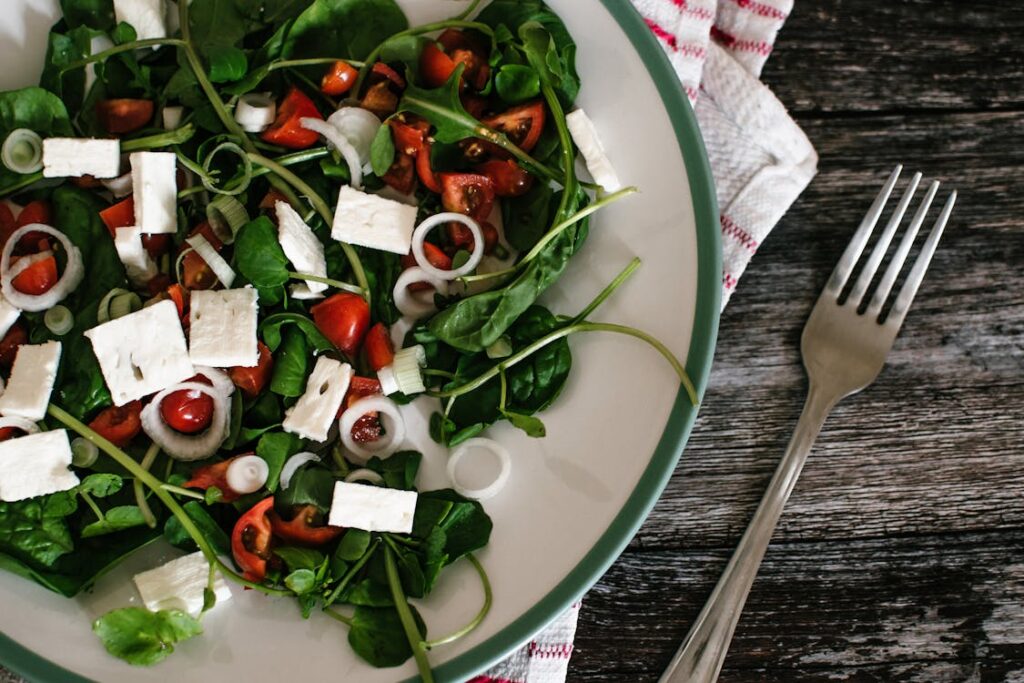Greek salad is also known as “Horiatiki” or “Xoriatiki” in Greece. It is a vibrant and refreshing dish that embodies the essence of the Mediterranean diet. This traditional salad is made with simple, fresh ingredients and has become a staple in Greek cuisine, enjoyed not only as a side dish but also as a light meal during the warm summer months. This article explores everything you need to know about Greek salad, including its ingredients, preparation, variations, and nutritional benefits.
The Classic Greek Salad Recipe
The traditional Greek salad is characterised by its simplicity. The main ingredients typically include ripe tomatoes, crisp cucumbers, green bell peppers, red onions, Kalamata olives, and a generous slice of feta cheese. The salad is seasoned with dried oregano, a drizzle of extra virgin olive oil, and a splash of red wine vinegar. Unlike other salads, lettuce is never used in an authentic salad, as the focus is on the crispness and natural flavours of the vegetables.
Ingredients:
- Tomatoes: Typically cut into wedges, providing a juicy base for the salad.
- Cucumbers: Sliced into thick half-moons, adding a refreshing crunch.
- Green Bell Peppers: Adds a mild sweetness and extra texture.
- Red Onions: Sliced thinly to give a pungent bite that contrasts with the creamy feta.
- Kalamata Olives: Known for their rich flavour, these olives are an essential component.
- Feta Cheese: Often served as a large slice on top of the salad, feta adds a creamy texture and salty taste.
- Extra Virgin Olive Oil: A key ingredient in Mediterranean cuisine, adding a silky finish to the salad.
- Red Wine Vinegar: A light acidic note to balance the richness of the cheese and oil.
- Oregano: A sprinkle of dried oregano enhances the aroma and taste, evoking the fields of Greece.
Preparing the Greek Salad
Making a Greek salad is straightforward and quick. Start by washing and preparing the vegetables. Cut the tomatoes into wedges, slice the cucumber, bell pepper, and onion, and place them in a large bowl. Add the olives, and then season the salad with salt, oregano, olive oil, and vinegar. Finally, place a block of feta cheese on top and drizzle with a bit more olive oil. This layering technique ensures that the flavors blend together beautifully.
Greek Salad Variations
While the traditional version of this salad remains a favourite, there are several variations that incorporate additional ingredients or modify existing ones:
- Greek Pasta Salad: Adding cooked pasta like orzo to the classic salad ingredients creates a heartier version that’s perfect for a more substantial meal.
- Watermelon Feta Salad: A summer twist that includes cubes of sweet watermelon alongside the salty feta, creating a delightful balance of flavours.
- Greek Lentil Salad: This protein-packed option includes cooked lentils, making it a filling choice for vegetarians.
- Grilled Halloumi Salad: Replace feta with grilled halloumi cheese for a unique twist that adds a smoky element to the dish.
Nutritional Benefits of Greek Salad
Greek salad is not only delicious but also a healthy addition to your diet. It’s low in calories and packed with essential nutrients. A single serving of this salad typically contains around 200-250 calories, making it an excellent choice for those looking to maintain a healthy weight. The salad is also rich in antioxidants, vitamins, and healthy fats, thanks to its fresh vegetables and olive oil.
Health Highlights:
Tomatoes: Rich in vitamin C and antioxidants like lycopene, which may help reduce the risk of heart disease.
Cucumbers: Provide hydration and contain vitamin K, important for bone health.
Olives and Olive Oil: Sources of healthy monounsaturated fats that promote cardiovascular health.
Feta Cheese: A good source of calcium and protein, though it should be consumed in moderation due to its sodium content.
Greek Salad in Modern Cuisine
Greek salad is incredibly versatile and can be paired with a variety of dishes. It complements grilled meats like lamb souvlaki or chicken gyros, making it a perfect side for barbecues or family dinners. It can also be enjoyed as a light lunch when served with crusty bread.
In Greek cuisine, the salad is often served at the beginning of a meal as a starter, but in the summer, it can stand alone as a refreshing lunch or supper option. For a traditional Greek experience, serve the salad with some village bread and a glass of ouzo or white wine.
Tips for Making the Perfect Greek Salad
Use high-quality ingredients: The freshness of the vegetables and the quality of the olive oil make a significant difference in the flavour.
Don’t overmix: Toss the salad gently to avoid crushing the vegetables and losing their crisp texture.
Serve immediately: Greek salad is best served fresh, as the vegetables can release water over time, diluting the flavours.
Final Thoughts
Greek salad is more than just a dish; it’s a representation of Greek culture and the Mediterranean way of eating. Its simplicity and reliance on fresh, wholesome ingredients make it a timeless recipe that has been enjoyed for generations. Whether you’re looking for a side dish to accompany your favourite main or a light meal on its own, this salad is a versatile and nutritious choice that will bring the taste of the Mediterranean to your table.
Read More: Exploring James Villas: A Premier Holiday Provider for UK Travellers
